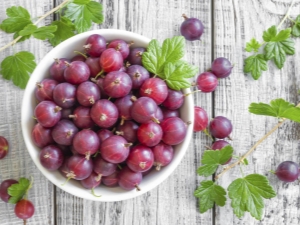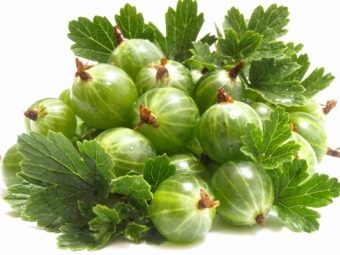When and how to collect gooseberries?

Gooseberry is a useful, beloved berry by many, growing practically all over the temperate zone.However, for some, it is easier to grow it than to gather it - then it is impossible to determine the exact time of collection, or thorny branches interfere too much. Let's try to figure out how to properly organize the harvest of this crop.
Determine the moment
It should be immediately understood that gooseberries can be harvested at different times - they depend on a particular variety (some ripen before others), and on the region’s climate (for ripening berries, certain weather conditions are needed), and on the weather in a given year. Consequently, it is better not to start from the specific month, but still from the degree of ripeness of the berries.
Moreover, the exact timing of the harvest also depends on the purpose for which the harvest is planned to be used. There are two types of gooseberry maturity - technical and consumer, they occur with a difference of about two weeks. Technical maturity is when the berries have already reached their normal size and have even begun to gradually turn into a characteristic “ripe” color, but still remain very dense and solid.
When used fresh, this product will seem green, but it is it that is better suited for heat treatment and further preservation - too soft berries from heating would simply crawl.
If the gooseberry wants to be consumed fresh, or at least without heat treatment, then better to wait until it is fully ripewhen the berries are completely colored and become softer. It is possible to estimate the degree of maturity and taste, having previously tried one thing.
It should be noted that such a product spoils rather quickly, and ripens in a ripped form is not too good, because for the sale and especially transportation use the crop harvested about three days before the consumer readiness.
An important criterion for determining ripeness is the presence of rain. If the warm time of the year is pampered with precipitation, then a significant part of the water gets into the berries, and therefore they are generally softer. In such a situation, it is not necessary to delay the collection, because the gooseberry is not brought to consumer maturity, starting to collect it to achieve technical maturity, even for fresh consumption. If you miss the moment and give the crop to color in the desired color, the berries are likely to start bursting right on the bush.
If the moment is missed and the harvest is still overcooked, it can still be used to make juice - fortunately, most varieties of this shrub are in no hurry to drop the berries in any condition.
In general, the collected product should not be stored for more than one and a half weeks, and even then only if it was collected in dry weather, since excess moisture greatly contributes to crop damage.
Dates by region
Most gardeners, especially those who have not yet tried to grow such a bush, want to know more precisely when exactly the planted gooseberries will bear fruit. Note that the first harvest should be expected no earlier than the third year after the landing of the bush. With regard to the time of harvest, then you can find different information about this - on the Internet appears and the middle of June and the end of August.
As we have already understood, this largely depends on the region, but also on the variety and on what purposes it is planned to use the berries. If we talk about Russia, the gooseberries ripen first of all, predictably, in the European part, and especially in the south - here there are ideal conditions for growing early varieties. It is here that the fresh berry appears first, because the harvest in June is not a wonder for anyone, and the middle of July may mark the end of the harvest. In the Moscow region, the conditions are not so different, but still this region is about one or two weeks behind.
With the eastward climate, the climate becomes more severe, because in the Urals in June the gooseberries rarely bear fruit - harvesting is theoretically possible at the end of June, but usually it is a question of the technical maturity of early-growing shrubs.In general, the whole season here is considered to be the whole of July. although the beginning of August also falls a bit.
In most of Siberia, conditions are even more severe, because even early-ripening varieties here usually yield crops only at the height of summer — in July, and closer to its second half. At the same time, late ripening varieties can ripen so late that in other regions they have already managed to forget about this fresh crop - there are cases when the gooseberry ripened in Siberia by the end of August.
Manual collection methods
The easiest and most obvious way to harvest from a gooseberry bush is manual, when each individual berry is simply picked. This method is good in many ways - for example, its application does not require any additional skills or tool costs, and the berries themselves retain their original qualities both outside and inside due to their sensitive assembly. Moreover, the plant does not suffer from such careful actions either.
Another thing is that many gardeners do not like manual assembling because of the possibility of pricking against sharp thorns, with which any specimen of this plant is thickly covered. A good way out of this situation is to use special clothes - then the harvest is not collected with bare hands, because they are protected by long sleeves and special gloves made of leather or suede.
However, in the process, the needles will cling strongly to the equipment, significantly slowing down the process, and even in gloves, it is difficult for a person to control the degree of depression of the berry, which is why the gooseberry often deforms and bursts. This harmful factor can be somewhat reduced if the fruits of consumer maturity are gathered together with the stem, but still the result does not always meet the best expectations.
Given the above drawbacks, many gardeners prefer to slightly improve the manual assembly. They refuse gloves because of the indicated minuses, preferring to tear berries with their bare hands, and in order to protect themselves from thorns, they use special plastic or wooden tongs.
Such a device is made long enough to pull any branch out of the bush's bush to the outside - then with the second, free hand, you can tear the gooseberries without fear of accidentally hitting the neighboring branches with prickles.
Mechanical methods
If the crop needs to be harvested quickly and in large volumes, it is more prudent to use methods with the active involvement of mechanical devices - this allows you to greatly reduce the time and protect your hands from damage. There are several such methods.
As an option, the gooseberry bush can simply be “shaken”, only this is done not entirely by hand. For a start, a plastic film or any clean and dense fabric is spread around the bush. Next, the branches alternately act with a vibrator, tilting them so that the berries, falling, fall on the flooring located on the ground. With the harvest of technical maturity, this method may not work, however, with consumer maturity, the berries keep on the stems rather weakly, therefore they are ready to fall to the ground even from relatively weak vibration.
After that, the fabric or film is gently pulled out from under the bush, so as not to scatter the collected material, and it is additionally doused with a directed stream of air - it allows you to immediately remove from the crop all other light impurities, including even small unripe berries. After that, it remains only to carefully sort the collected in size and quality of gooseberries.
If such a method seems to be technically difficult, you can somewhat improve the method of manual collection. A thimble for the thumb is used as a cunning device, to which a kind of "comb" is attached that resembles a rake - this is usually made of metal on its own, providing it with five to six centimeter teeth.Such a device allows you to comb through the prickly branches, knocking off the ripe, and therefore poorly holding fruits, and they can fall on all the same oilcloth or fabric.
See below for an overview of an interesting gooseberry harvesting tool.
Storage rules
The farm is not always taken immediately to use the harvest, and in fact the gooseberry does not apply to those berries that are stored for a long time fresh.
Even in ideal harvesting conditions, when dry weather is outside, this culture is stored for no more than ten days, and experienced gardeners advise to start cleaning only after the dew has completely dried.
After collecting the gooseberries, it is advisable to eat or preserve as quickly as possible, however, in the old days another method was used to preserve the berries for a long time - they were simply dried. To do this, you need a dry and warm place where there will be an opportunity to scatter berries in a thin layer.
Today, refrigeration equipment will help in preserving the berries in a relatively fresh form, because at zero temperature the gooseberry is stored for up to five to six weeks, and with a slight frost wrapped in plastic - up to three months.
Separately, it should be noted that all experts as one do not recommend storing gooseberries in large containers - even a small defect or spoilage of one of the berries in the shortest possible time can spread to the entire volume. Without processing, berries are stored in containers and dishes of no more than five liters, but the harvest of consumer ripeness should not be kept at all in excess of two liters. The same goes for cold storage.
Another important point is the diligent protection of the fruit from moisture penetration. Not for nothing, harvesting is carried out only in dry weather and only after the dew has dried out - even a few drops of water can provoke a rapid deterioration of the entire contents of the container. For this reason, preference is given to hermetically sealed containers, and in refrigerator conditions, the product should be stored as far as possible from various liquids.

































